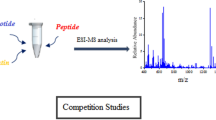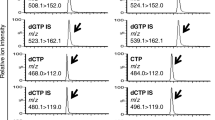Abstract
Oxaliplatin is a third-generation platinum complex, and has a broad spectrum of antitumor activity. Such platinum complexes with the DACH carrier ligand have recently received increasing attention since they show efficacy against cisplatin-resistant cell lines. As the foremost indication of antitumor activity of platinum drugs is the formation of adducts with genomic DNA, calf thymus DNA-oxaliplatin adducts were the major target in this study. Calf thymus DNA was incubated with oxaliplatin, resulting in the formation of a large number of platinum-DNA adducts. Treated DNA was digested into the dinucleotides with a combination of enzymes, namely, benzonase, alkaline phosphatase, and nuclease S1. Using a high-performance liquid chromatography, we carried out the separation of individual platinum-DNA adducts which were concurrently identified using electrospray ionization ion trap mass spectrometry (MS). Both 1,2-intrastrand and 1,2-interstrand cross-linked adducts were found; however, those of the intrastrand nature have a considerably higher abundance than those of the interstrand cross-links. Among them, d(GpG)-oxaliplatin was the most abundant bifuctional adduct. To a lesser extent, a few monofunctional adducts were detected as well. MSn experiments served to ascertain the detailed structures of oxaliplatin adducts of dinucleoside monophosphates and of dinucleotides.

Three-dimensional view of the d(GpG)-Pt(DACH) adduct of m/z 902 (a) and of the d(ApG)-Pt(DACH) adduct of m/z 886 (b). DACH 1,2-diaminocyclohexane, green phosphorus, red oxygen, light blue carbon, dark blue nitrogen, gray platinum












Similar content being viewed by others
References
Misset JL, Bleiberg H, Sutherland W, Bekradda M, Cvitkovic E (2000) Crit Rev Oncol Hematol 35:75–93
Cunningham D (2006) EJC Suppl 4:10–13
Malina J, Novakova O, Vojtiskova M, Natile G, Brabec V (2007) Biophys J 93:3950–3962
Saris CP, van de Vaart PJM, Rietbroek RC, Blommaert FA (1996) Carcinogenesis 17:2763–2769
Woynarowski JM, Chapman WG, Napier C, Herzig MCS, Juniewicz PE (1998) Mol Pharmacol 54:770–777
Woynarowski JM, Faivre S, Herzig MCS, Arnett B, Chapman WG, Trevino AV, Raymond E, Chaney SG, Vaisman A, Varchenko M, Juniewicz PE (2000) Mol Pharmacol 58:920–927
Faivre S, Chan D, Salinas R, Woynarowska B, Woynarowski JM (2003) Biochem Pharmacol 66:225–237
Eastman A (1987) Pharmacol Ther 34:155–166
Chaney SG, Campbell SL, Bassett E, Wu Y (2005) Crit Rev Oncol Hematol 53:3–11
Gately DP, Howell SB (1993) Br J Cancer 67:1171–1176
Perez RP (1998) Eur J Cancer 34:1535–1542
Aebi S, Kurdi-Haidar B, Gordon R, Cenni B, Zheng H, Fink D, Christen RD, Boland CR, Koi M, Fishel R, Howell SB (1996) Cancer Res 56:3087–3090
Fink D, Nebel S, Aebi S, Zheng H, Cenni B, Nehmé A, Christen RD, Howell SB (1996) Cancer Res 56:4881–4886
Vaisman A, Varchenko M, Umar A, Kunkel TA, Risinger JI, Barrett JC, Hamilton TC, Chancy SG (1998) Cancer Res 58:3579–3585
Jennerwein MM, Eastman A, Khokhar A (1989) Chem Biol Interact 70:39–49
Küng A, Strickmann DB, Galanski M, Keppler BK (2001) J Inorg Biochem 86:691–698
Almeida GM, Duarte TL, Steward WP, Jones GDD (2006) DNA Repair 5:219–225
Goodisman J, Hagrman D, Tacka KA, Souid AK (2006) Cancer Chemother Pharmacol 57:257–267
Le Pla RC, Ritchie KJ, Henderson CJ, Wolf CR, Harrington CF, Farmer PB (2007) Chem Res Toxicol 20:1177–1182
Hah SS, Sumbad RA, de Vere White RW, Turteltaub KW, Henderson PT (2007) Chem Res Toxicol 20:1745–1751
Baik MH, Friesner RA, Lippard SJ (2003) J Am Chem Soc 125:14082–14092
Mantri Y, Lippard SJ, Baik MH (2007) J Am Chem Soc 129:5023–5030
Scheeff ED, Briggs JM, Howell SB (1999) Mol Pharmacol 56:633–643
Sharma S, Gong P, Temple B, Bhattacharyya D, Dokholyan NV, Chaney SG (2007) J Mol Biol 373:1123–1140
Janning P, Schrader W, Linscheid M (1994) Rapid Commun Mass Spectrom 8:1035–1040
Schrader W, Linscheid M (1995) J Chromatogr A 717:117–125
Bartolini WP, Bentzley CM, Johnston MV, Larsen BS (1999) J Am Soc Mass Spectrom 10:521–528
Hagemeister T, Linscheid M (2002) J Mass Spectrom 37:731–747
Pullman A, Pullman B (1981) Q Rev Biophys 14:289–380
Yuriev E, Orbell JD (1996) Inorg Chem 35:7914–7915
Arpalahti J (1999) In: Lippert B (eds) Cisplatin chemistry and biochemistry of a leading anticancer drug. Wiley-VCH, Weinheim
Rodgers MT, Campbell S, Marzluff EM, Beauchamp JL (1994) Int J Mass Spectrom Ion Process 137:121–149
Monjardet-Bas V, Bombard S, Chottard JC, Kozelka J (2003) Chem Eur J 9:4739–4745
Hagemeister T (2003) Ionenfallen-Massenspektrometrie von Cisplatin-DNA-Addukten. Logos, Berlin
Gupta R, Beck JL, Sheil MM, Ralph SF (2005) J Inorg Biochem 99:552–559
Pan S, Verhoeven K, Lee JK (2005) J Am Soc Mass Spectrom 16:1853–1865
Monn STM, Schürch S (2007) J Am Soc Mass Spectrom 18:984–990
Wang Z, Wan KX, Ramanathan R, Taylor JS, Gross ML (1998) J Am Soc Mass Spectrom 9:683–691
Springer A, Bürgel C, Böhrsch V, Mitrić R, Bonačić-Koutecký V, Linscheid MW (2006) ChemPhysChem 7:1779–1785
Frańska M, Frański R, Schroeder G, Springer A, Beck S, Linscheid M (2005) Rapid Commun Mass Spectrom 19:970–974
Acknowledgements
We are grateful to the Arab Republic of Egypt for a grant to S.M. and to the DFG for financial support to M.L.; Stefan Pieper’s expert technical assistance with the mass spectrometer is also gratefully acknowledged.
Author information
Authors and Affiliations
Corresponding author
Additional information
Abbreviations
They are shown in Fig. 1
Rights and permissions
About this article
Cite this article
Mowaka, S., Linscheid, M. Separation and characterization of oxaliplatin dinucleotides from DNA using HPLC-ESI ion trap mass spectrometry. Anal Bioanal Chem 392, 819–830 (2008). https://doi.org/10.1007/s00216-008-2311-6
Received:
Revised:
Accepted:
Published:
Issue Date:
DOI: https://doi.org/10.1007/s00216-008-2311-6




